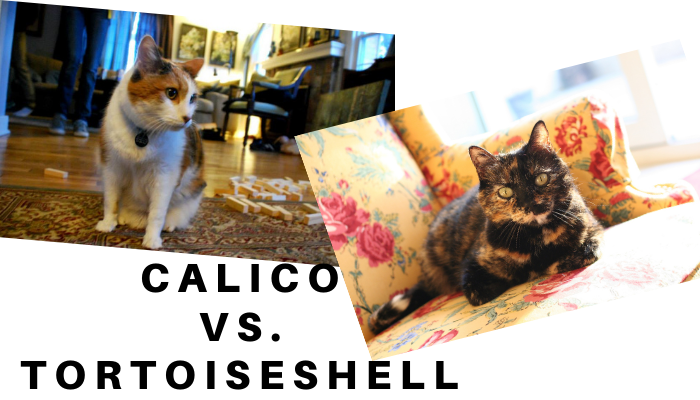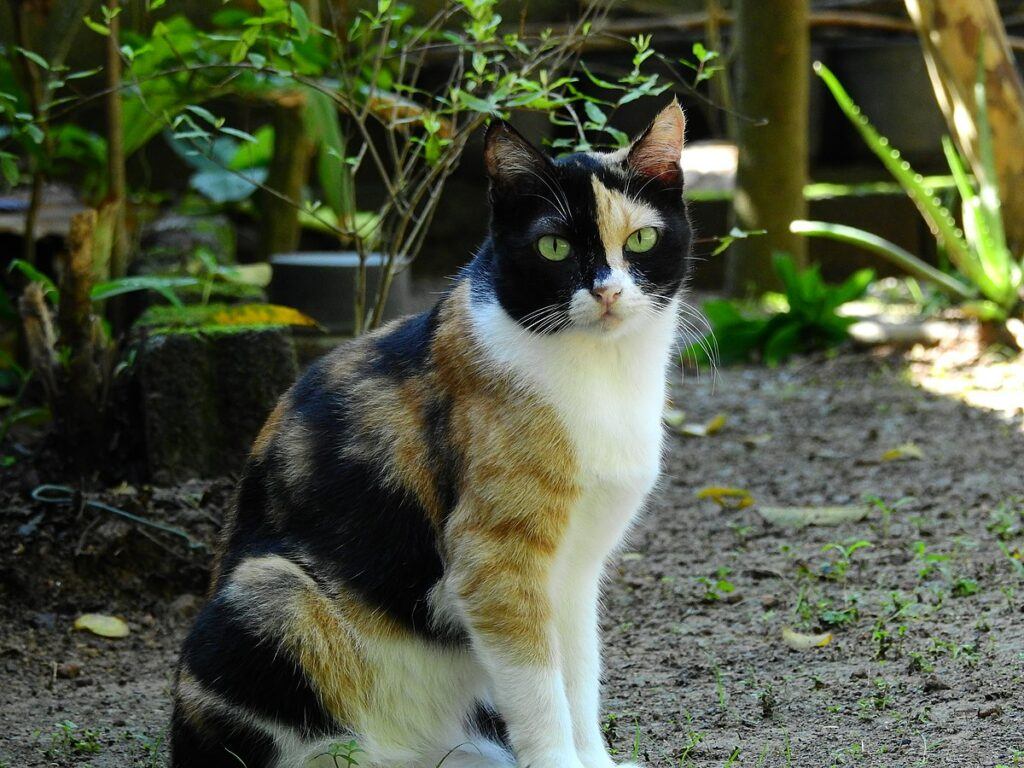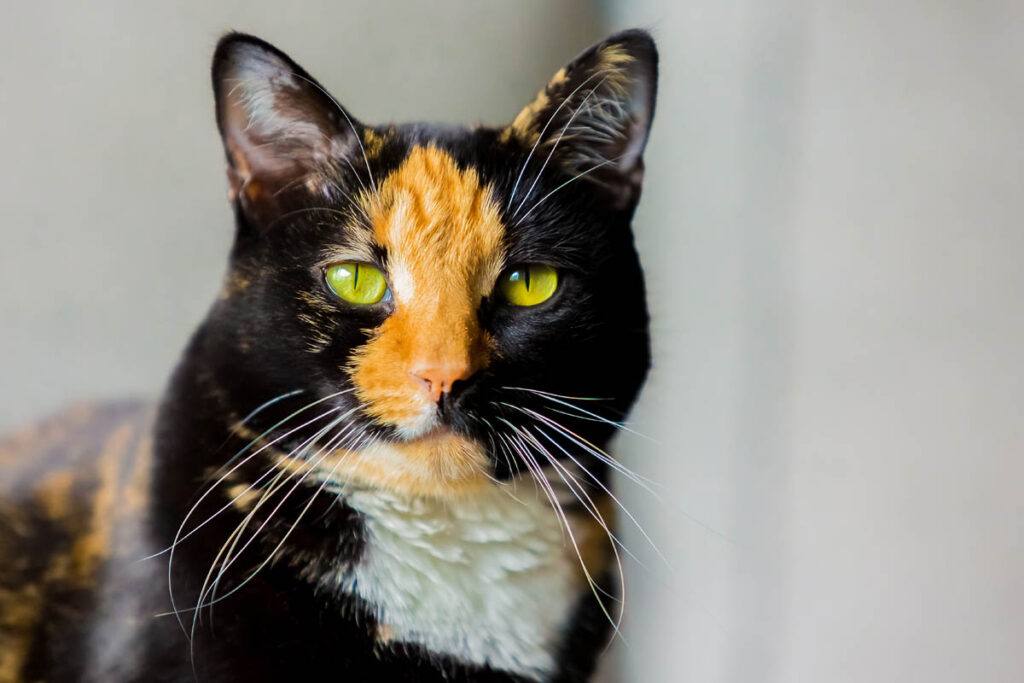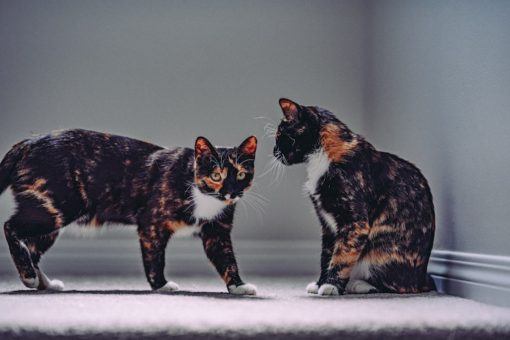This post may contain affiliate links. This means I may receive a small commission if products are purchased through them. All opinions are honest and remain my own.
If you look at enough of them, it’s easy to see why calico and tortoiseshell cats (also known as tricolor cats) are commonly confused. So what really is the difference between a calico vs. a tortoiseshell cat?
Contrary to popular belief, these terms both refer to the coloring of a cat’s coat, not a specific breed. Both calico and tortoiseshells (commonly nicknamed “torties”) are seen across many different types of cat breeds.

What’s the difference between calico and tortoiseshell cats?
The basic difference between these cats is that calicos have a lot of white with distinct orange and black patches. Torties, on the other hand, are usually black (or brownish) with orange mixed in a mosaic pattern. When you compare a classic calico to a classic tortie, they’re pretty easy to tell apart.
However both of these cats can demonstrate a range of varying colors and patterns. Sometimes, tortoiseshells can have white patches too (known as “tortoiseshell and white”). This can make telling the difference between the two confusing.
The way you can tell apart a tortoiseshell cat with white in its fur vs. a calico cat, is calico cats are white with distinctive black and orange blotches. Tortoiseshells tend to display a more mosaic pattern of brown or black and orange mixed together, and they can have white patches on the their underbelly, paws, chest, or face.


Basic differences between torties and calicos
Similarities
- Both terms describe specific coat coloring, not a breed
- Calicos and Torties can both have orange, black, and white fur
- Almost exclusively females (99.9%), male tortoiseshells and calicos are very rare
- Neither can be bred, they’re the result of random genetics
Differences
- Tortoiseshell cats are largely black/brown with orange/reddish orange coloring mixed in to varying degrees.
- Calico cats are white with patches of orange and black
- A tortoiseshell with white cat won’t be majority white, it will only have certain areas of white, like on the chest, belly, or paws.
Are calico and tortoiseshell cats rare?
Cats with these color patterns aren’t rare in general, however male calicos and tortoiseshells are both super rare. About 1 in every 3,000 calicos and 1 in every 3,000 torties is born male.
The reason for this comes down to genetics. The sex chromosomes X and Y determine whether a cat will be male or female. So if a cat gets the XY chromosomes, it will be male, and if it gets the XX chromosomes, it will be female.
Because the orange and black color code is attached to the X chromosome, calicos and torties need the double X chromosomes in order to have a chance of displaying the classic coat coloring.
However it’s a bit more complicated than this since obviously not all female cats have the coat coloring of a calico or tortoiseshell. A cat would need to inherit two X chromosomes – 1 with the orange code and 1 with the black code – in order to display the coat.
And then, the cells would have to undergo a process called X-inactivation to produce the brindled appearance of orange and black coloring of torties.
To Quote Wikipedia…
“The cells of female cats, which like other mammalian females have two X chromosomes (XX), undergo the phenomenon of X-inactivation,[12][13] in which one or the other of the X-chromosomes is turned off at random in each cell in very early development.
The inactivated X becomes a Barr body. Cells in which the chromosome carrying the orange (O) allele is inactivated express the alternative non-orange (o) allele, determined by the (B) gene. Cells in which the non-orange (o) allele is inactivated express the orange (O) allele.
Pigment genes are expressed in melanocytes that migrate to the skin surface later in development. In bi-colored tortoiseshell cats, the melanocytes arrive relatively early, and the two cell types become intermingled, producing the characteristic brindled appearance consisting of an intimate mixture of orange and black cells, with occasional small diffuse spots of orange and black.“
Source: Wikipedia
In calico cats, they inherit a separate “spotting gene” which produces the white fur in addition to the black and orange patches.
So how could a male cat possibly be calico or tortie if they need the XX chromosomes of a female?
The reason it’s even possible for male cats to display classic tortoiseshell or calico coloring is usually due to a rare genetic condition known as Klinefelter syndrome, in which the cat has an extra X chromosome (XXY).
Because of this fact, these male cats are almost always sterile and can have other health problems.
Variations among calicos and torties
While there are classic torties and calicos, there is also a large gray area in between. Have you ever looked at these cats and quite honestly have not been able to tell the difference?

This is because genetic variations are too widely variable to fit into a box! Since calicos and torties are just terms for coat colorings and not breeds, there is a huge gray area in between the two.
Tortoiseshells with white vs calicos
The most confusing variable is that sometimes, tortoiseshell cats have white in their fur in addition to brownish/black and orangish/red. However, it can help if you think of calico cats as white cats with black/brown and orange patches. It’s common for them to be majority white, but they can have anywhere from a quarter to three quarters of white fur on their body.

Tortoiseshell and white cats don’t really have the distinctive patches of orange/black, they will still mostly have a darker coat. But they may have white patches on their paws, face, underbelly, or chest.
Dilute calicos, calibys, torbies
Some calicos have very pale orange and black coloring, these are known as “dilute calicos”. There are also tabby calicos, referred to as “calibys”. Tabby tortoiseshells are called “torbies”.
Mixed calico/tortoiseshell
Some cats even have a mix of both distinctive calico and tortoiseshell coats, and it can be extremely difficult to truly discern which it is.
Personality
Some people claim both torties and calicos have “tortitude” – loyal, strong-willed, with an attitude. They’re also known to be talkative, playful, and sometimes aloof.
While this seems to appear true based on our experience and other anecdotal stories, the truth is there is no actual hard evidence that personality traits are linked to coat coloring. Each and every cat is an individual, with a range of varying personality traits.
How much does a calico cat cost? What about a tortoiseshell?
Calico and tortoiseshell cats are NOT a breed, their unique coat coloring is due to very complicated genetics. Therefore, they can’t be bred and there are no “calico cat breeders”. You can easily find these cats available for adoption at a local shelter for a typical adoption fee, usually around $75 – $100.
That being said, it’s possible that a purebred cat can also have a calico or tortoiseshell coat markings, and those may be more expensive because they are quite rare.
For example, Maine Coon calicos and torties are rare and highly popular. A Maine Coon breeder who has a calico or tortie kitten may charge as much as $2,000 for it.
Are male calicos and tortoiseshell cats worth money?
Male calico and tortoiseshell cats, despite being an extreme rarity, are not really worth more than any other regular cat. These cats can only be male if they suffer from Klinefelter Syndrome, a rare genetic condition in which they have an extra X chromosome.
This makes them (almost always) sterile and suffer from additional health issues. Also, just like female calicos or torties, they can’t be bred and there’s not any specific price for them.
Also check out: Calico and Tortoiseshell Cat Names
The Bottom Line
Calicos and tortoiseshell cats are gorgeous creatures, each one unique. Although they can be confusing to tell apart, once you know a few distinguishing features of each then it becomes much easier.

Leave a Reply